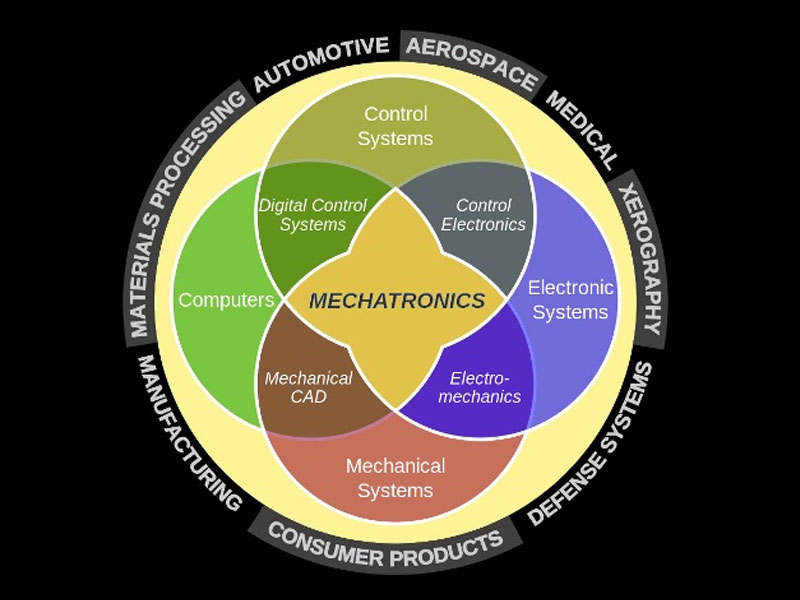Mechatronics has been hailed as the innovation engine behind the fourth industrial revolution. That’s quite a forcible claim. So where did the term originate and why, what are its current applications and how is it leading the future of CNC manufacturing?
I read a lot of industry literature and pride myself on knowing the lingo, but with so much jargon out there it’s often more expedient to just skim over the buzzwords. Confronted with the word “Mechatronics”, OK I get the gist, but is it simply a generic catch-phrase, or is there more to the story?
Mechatronics is a bit like a manufacturing Magimix, blending a wide variety of engineering disciplines such as mechanical engineering, electronics, computer engineering, telecommunications engineering, systems engineering, control engineering and more. But thinking of all these disciplines as distinctly separate is a thing of the past.
The term mechatronics was coined in Japan in the 1960s, originating from the budding field of robotics. Early on, robot arms were uncoordinated and had no sensory feedback. Combining prevailing programming, sensor and control technologies resulted in the design of far more fluid and better coordinated robotic movements.
As mechatronic methods progressed, it began to be used in vending machine technology, auto-focus cameras and automatic doors. In the 1980s, microprocessors were introduced into mechanical systems and by the 1990s, computer intelligence was applied to mechatronic engineering.
In order to reap the rewards of mechatronics, the way in which machines were traditionally designed had to change. Mechanical engineers would design a machine or device, and only afterwards provide control and programming solutions; the work done separately by computer or software engineers. Only when they started applying a mechatronics approach to design, development, and fabrication, did engineers realize just how inefficient their old methods really were.
Mechatronics engineers can now improve upon speed, reliability and flexibility of myriad interrelated processes used in CNC manufacturing such as:
TOOL MONITORING: Uninterrupted machining is like the holy grail to manufacturers, who are always striving to meet production targets and quality demands. Tool wear is a critical weak link. Automated, real-time tool monitoring systems check the condition of cutting tools throughout the machining process, predicting tool wear before it causes damage to the machine tool and work piece. Mechatronics-based tool-wear monitoring and alarm systems have become an integral part of automated tool rooms and unmanned factories.
FLEXIBLE MANUFACTURING SYSTEMS (FMS): Due to market demands, manufacturers are moving away from mass production in favor of small-batch runs. FMS combines microelectronics and mechanical engineering to apply all the cost-effective elements of large scale production to batch work. A central online computer controls the machine tools, work stations, and the transfer of components and tooling. The computer also provides real-time monitoring and information control. This mechatronic system of flexibility and control, makes the production of a wide range of products in small batches not only possible but profitable.
COMPUTER INTEGRATED MANUFACTURING (CIM): The goal is to create a total manufacturing enterprise by integrating computer technologies such as CAD/CAM and automation technologies such as robotics and materials handling, with management tools such as data communications and organizational systems. All the operations involved in the life cycle of a product can then be formed from individual islands of activity, into a uniformed continent; controlled and documented at a single source. This Mechatronic approach not only boosts productivity on the factory floor, but also allows manufacturers to stay better connected with their customers and markets.
INDUSTRIAL ROBOTS: This field in particular demonstrates the successful synthesis of mechanical, electronic, and computer engineering. Industrial robots are defined as re-programmable machines which respond to sensory signals received from the system environment. Based on these signals, robots carry out programmed work or activities. They can take simple independent decisions and communicate or interact with other machines and the central computer; performing functions such as parts handling and processing along with various stages of product construction ̶ especially on assembly lines. Even the building of the robots themselves is essentially mechatronic; integrating the many sophisticated mechanical and software systems required in robotic design.
AUTOMATIC QUALITY CONTROL & INSPECTION: An array of sensors, data acquisition systems, machine vision systems, metrology instruments and more, are being used to monitor and analyze part quality; both with and without operator assistance. Mechatronic quality control operations are carried out right from the start of product design, using simulation software and digital imaging to predict performance. The integration of sensor technologies, signal conditioning devices and data conversion devices have become a hallmark of quality control in mechatronic automated manufacturing.
IN THE NEAR FUTURE: The future of technological innovation will definitely involve multi-disciplinary expertise. Mechatronics’ true value for manufacturing will be in its ability to create a seamless unification and standardization of all existing design and manufacturing processes, while incorporating the steady stream of new emergent technologies continually being added to the mix. A reliable connectivity hub of mechatronic engineering know-how will be the key to unlocking a new, more powerful era in CNC manufacturing.
Author: Marie Orian at Colibri Spindles Ltd


